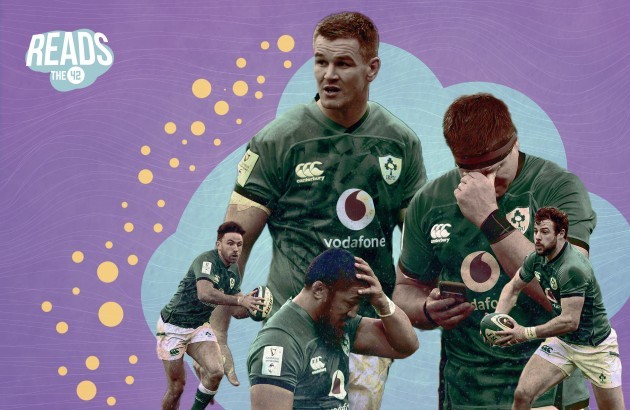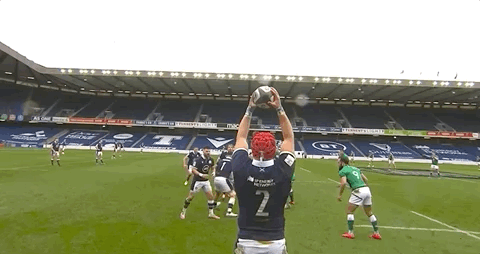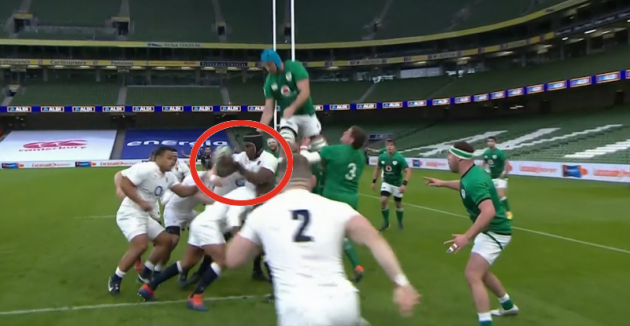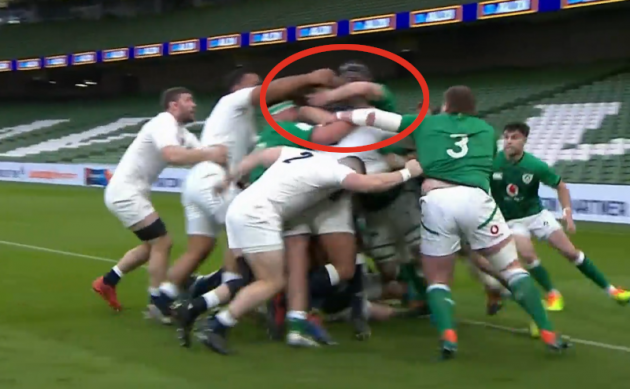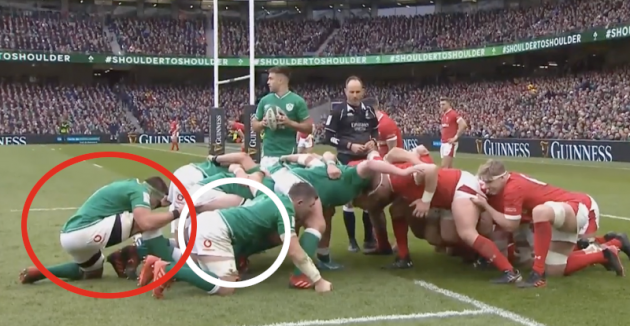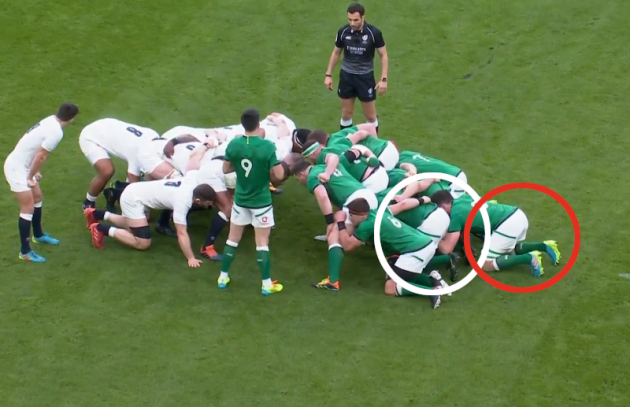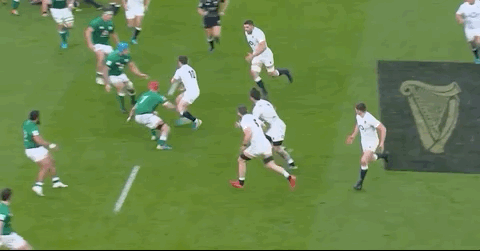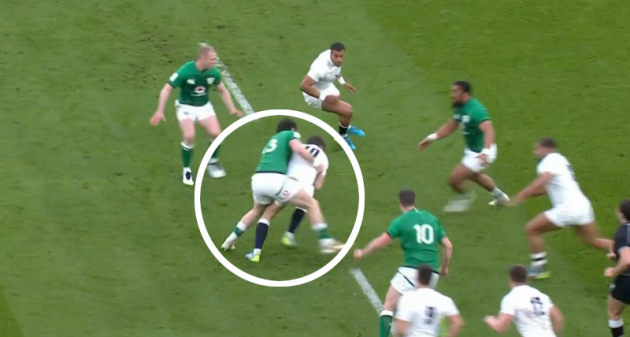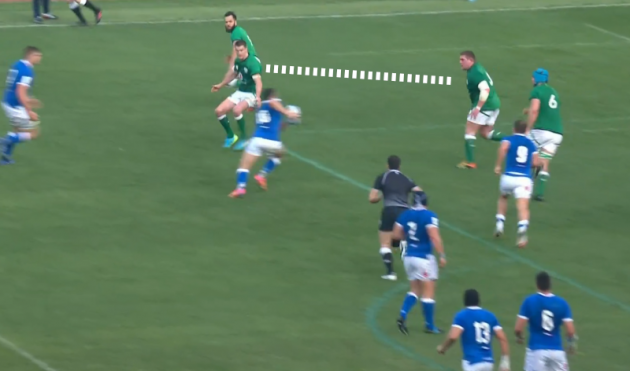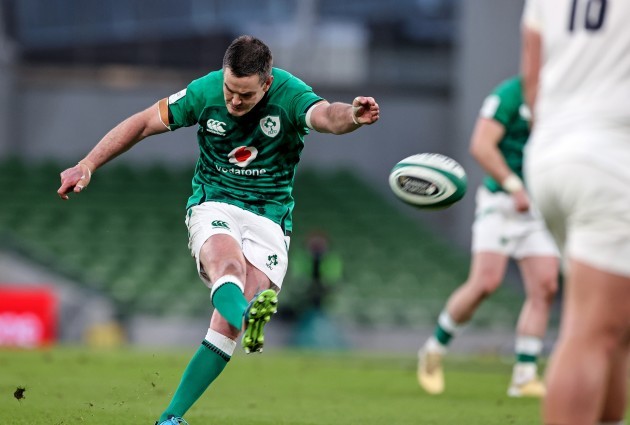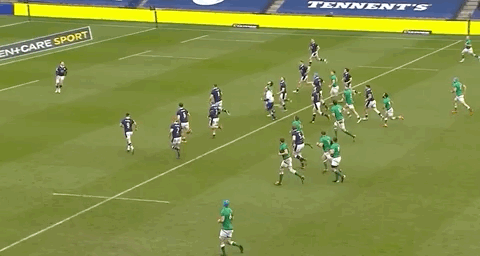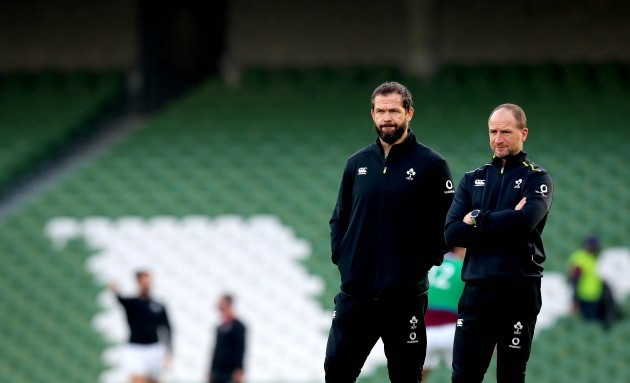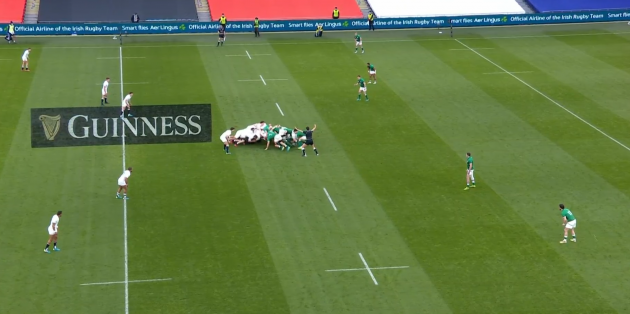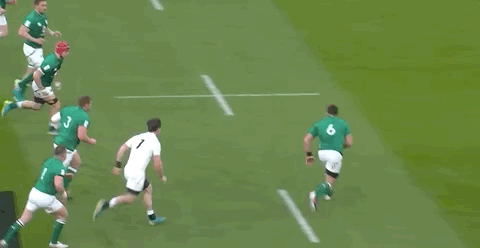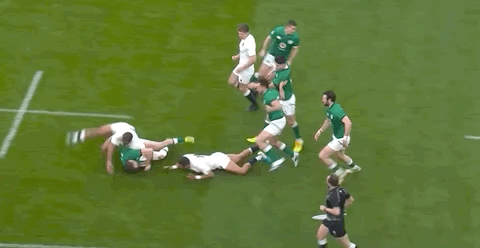WHILE IRELAND ENDED on a major high against England last weekend, a second consecutive third-place finish in the Six Nations means Andy Farrell’s side fell short of their ambitions and the IRFU’s stated objectives.
To be fair, most people would have predicted a third-place finish for Ireland before this Six Nations, albeit without a win over Eddie Jones’ England.
Farrell and his coaching staff will reflect on this campaign with a sense of regret that their performance level against England didn’t come earlier in the championship. Defeats in their opening two games left them chasing to save their Six Nations, which they did with three consecutive wins.
Here, we break down Ireland’s performance in the key areas of the game in this championship.
Lineout
New forwards coach Paul O’Connell has had a clear impact in his first few months in the role, encouraging Ireland’s pack towards a superb defensive lineout performance in particular.
Ireland won 14 of their opponents’ throws into the lineout in this Six Nations – a remarkable 20% of all opposition throws – leaving them well clear of second-best Scotland’s nine.
Nine of Ireland’s 14 were steals in the air, with James Ryan leading the way on four steals, Tadhg Beirne picking off two, and CJ Stander, Iain Henderson and Rhys Ruddock stealing one apiece.
Ireland’s aggressive tactics also led to a further opposition handling error in the lineout, as well as three overthrows and a free-kick turnover when Scotland delayed their throw amidst intense pressure.
Scotland’s total collapse at the lineout in Murrayfield in round four highlighted Ireland’s ability to cause panic with their aggressive defence, which was enhanced by the quality of O’Connell’s analysis.
- For more great storytelling and analysis from our award-winning journalists, join the club at The42 Membership today. Click here to find out more >
In the likes of Ryan, Beirne, Henderson, and Peter O’Mahony, Ireland have several top-class defensive lineout jumpers, while strong lineout lifters such as Tadhg Furlong, Andrew Porter, Cian Healy, Dave Kilcoyne have been important too.
Last weekend’s game against England was the only one in the championship where Ireland didn’t get a steal, with Eddie Jones’ side also nearly turning Ireland’s aggression in the air against them when Maro Itoje caught a low throw five metres out.
We can see that Beirne is in the air – and possibly could have conceded a penalty for jumping across – as England suddenly power towards the tryline.
It takes an important intervention from Henderson to wrap the ball and help to hold England up over the tryline.
England threw to a player on the ground on two other occasions in this game as they looked to circumvent the Irish lineout defence, with Kyle Sinckler the target at the front on both occasions.
They got the ball away cleanly the first time. However, on the second occasion, Henderson recognises the ploy and breaks forward from the tail of the lineout…
… meaning he can close off Billy Vunipola’s passing channel away from the lineout and force him to carry into traffic in front of him.
These England examples show how opposition teams are now attempting to plot ways to avoid Ireland’s lineout defence or even turn it into an opportunity. O’Connell and his players will be excited to continue their progress in this area whenever Test rugby resumes.
As for their attacking lineout, Ireland will feel there is plenty of work ahead of them as they look to build on a solid foundation.
Their 89% success rate left them behind England [95%] and Wales [91%], but Ireland’s ‘lineout effectiveness’ – which accounts for ball won cleanly rather than just retained – was the second-lowest in the championship at 81.5%.
Henderson – Ireland’s primary caller – won more lineouts than any other Irish player with 15, although Beirne was just behind on 13. Ryan – who missed lots of the Six Nations due to head injuries – won six, while Ryan Baird, Jack Conan, Ruddock, O’Mahony, and Stander all claimed lineouts too.
First-choice hooker Rob Herring’s throwing was the fourth most accurate in the Six Nations at 89.2% on his 37 throws, behind Luke Cowan-Dickie on 100% for his 32 throws, Dave Cherry at 93.8% on his 16 throws, and Ken Owens on 89.3% for his 56.
Ireland’s replacement hooker Rónan Kelleher had 17 throws for an 88.2% success rate.
As with most teams, the lineout remains the key platform for Ireland tries, with nine of their 12 tries in this year’s championship starting with their own throw into the set-piece.
As discussed previously, Ireland’s lineout attack hit a new peak against England and that must be the standard moving forward.
O’Connell will also be keen to develop Ireland’s maul into an even more potent weapon.
Ireland nearly scored through James Lowe against France after a strong maul on the right-hand-side, while Will Connors finished from a maul against Italy, a game in which the maul was also crucial in the build-up to Hugo Keenan’s try.
Scrum
Scrum coach John Fogarty can be very pleased with how this area of Ireland’s game performed in the Six Nations. Tadhg Furlong’s celebration of a second-half scrum penalty against England underlined his team’s continuing growth here.
Ireland won 91% of their own scrums and were the only team in the competition not to concede a penalty on their own put-in. Their only two scrum losses were free-kick concessions for early drives.
Ireland won four penalties on their own put-in and also won a championship-leading five penalties on the opposition put-in, as well as a crucial free-kick on their own five-metre line against England last weekend.
Even with changes to his front five over the course of the Six Nations, Fogarty has guided the Irish scrum to impressive consistency.
As with Leinster in the wake of Saracens demolishing their scrum, Ireland made a change to their scrum set-up for this year’s championship.
Below is a shot from the 2020 Six Nations, showing Ireland’s locks starting with just one knee on the ground [white], their outside leg planted in front of them in a ‘split stance.’
Meanwhile, number eight CJ Stander [red] is hanging off the back of the scrum initially on one knee, rather than starting with his shoulders against the second rows and with both knees on the ground.
Now contrast that image with the one below against England last weekend just before Ireland win a scrum penalty that Sexton slots for three points.
Ireland’s second rows start with both knees on the ground in a ‘square stance’, as number eight Conan also starts with both knees on the ground and his shoulders against his second rows.
Ireland’s new approach is generally thought to result in a steadier scrum due to the fact that the second rows don’t have to change their foot positioning, while Conan helps to keep them tightly bound and low.
The change in set-up has worked well for Ireland and, again, there will be excitement about building on the excellent work in this department.
Ireland still have a huge amount of work to do on their strike plays from this strong scrum platform, however. They were the only team in the Six Nations not to score a single try from a scrum this year.
Breakdown
Ireland’s accuracy at the breakdown was inconsistent last year but this is another area of real improvement in 2021, with O’Connell adding nous in this department.
No one had a higher ruck success rate than Ireland’s 97% in this Six Nations, while the average speed of their rucks was 2.89 seconds, a figure that only Italy bettered [2.82 seconds].
There were still some isolated instances of players over-committing to rucks but Farrell’s men generally made a real impact with their first two arrivals to clear away turnover threats.
Defensively, Ireland have made an impact too – though this has always been a strength of theirs.
The average ruck speed for Ireland’s opponents has been 3.68 seconds, which leaves them second only to England’s 3.88.
Irish players have always enjoyed competing for turnovers at the breakdown and Beirne has been the jackal king in that sense.
The Munster man earned eight jackal turnovers in the five games, with Henderson next best on five. Robbie Henshaw and CJ Stander made two turnovers each at the breakdown, while Cian Healy, Garry Ringrose, Jack Conan, Keith Earls, Herring and Kelleher all had one apiece.
The range of Ireland’s jackal threats is a huge strength and means attacking sides must be wary at all times.
Defence
Of course, Ireland’s breakdown qualities are a key part of their defensive strategy under Simon Easterby, who handed over forward coaching duties to O’Connell this year in order to focus fully on defence rather than combining the two roles as before.
The jackal turnovers have been very pleasing, while Ireland also made 11 turnovers in tackles in this Six Nations, either by forcing the ball-carrier into spilling the ball or through their longstanding choke-tackling strength.
Henshaw was particularly effective with the latter technique against England, with his choke tackle on George Ford in the 15th minute handing Ireland crucial momentum.
In an overall sense, Easterby will likely be relatively pleased with Ireland’s efforts in this Six Nations, while acknowledging that there are improvements still to be made if their defence is to become a top-tier threat.
Ireland limited their opposition to an average of two tries, six breaks, and 18 defenders beaten per games, with only Scotland [who have a game against France still to go, of course] performing better in those categories.
However, Easterby will have been frustrated with several sloppy defensive moments costing Ireland.
James Lowe paid the price for his errors against Scotland [and previously against Wales] by being dropped for the England game, while Italy scored a relatively soft try against Ireland when Sexton got disconnected from Furlong, leaving the prop advancing laterally, and Jordan Larmour missed a tackle.
In the defeat to France, Ireland’s structured defence off lineouts was cut apart on a couple of key occasions with similar plays and will have given Easterby plenty of food for thought in ensuring that Ireland can make systematic tweaks even during games depending on how the opposition looks to break them down.
Discipline
The penalty count is a huge part of Test rugby and this is another area Ireland will view as having room for improvement.
Keeping the penalty count below double figures can go a long way towards winning games, denying the opposition chances to kick into your half and attack or simply kick points, but Ireland just slipped above that marker with an average penalty count of 10.4.
Interestingly, France – long considered the least disciplined team in the Six Nations – have conceded the fewest penalties on average at 8.3 per game with one fixture left, while England’s average of 14.6 has been disastrous for them.
Kicking
Kicking from the tee remains as important as ever in rugby and Sexton’s 22-point haul was crucial last weekend against England.
The 35-year-old’s goal-kicking was superb in this championship as he slotted 25 of his 26 efforts for a competition-leading 96% success rate.
Billy Burns had two shots at goal for Ireland in this Six Nations and successfully kicked one of them, while Ross Byrne kicked both of his attempts at the posts.
Ireland kicked more penalties than any other team and Sexton’s accuracy underlines the enduring importance of keeping the scoreboard moving when the opposition’s discipline allows. While Ireland have opted to go into the corner chasing tries on many occasions, Sexton’s prolific streak off the tree was positive.
Kicking coach Richie Murphy will also have been happy with some elements of Ireland’s kicking in play, which has been an inconsistent part of their game in recent years.
In this year’s championship, Ireland’s average of 30.2 kicks in play per game is higher than anyone else’s.
They were probably fortunate not to be punished to a greater extent for some poor box-kicking against Scotland, but that game did see them get crucial success from Sexton’s kicking, most notably for Henshaw’s try.
The inside centre initially batted a Sexton garryowen back for Ireland to reclaim the ball…
… before Sexton’s cross-field kick intended for Earls bounced high to allow Henshaw to follow up and dot down.
Earls nearly scored from a Sexton cross-field kick against England last weekend, while Jack Conan’s try featured a Sexton contestable that Hugo Keenan superbly reclaimed.
Ireland used James Lowe’s cannon of a left boot heavily in this Six Nations – 24 times in four games – and he was particularly useful in helping them to exit their own half, a role the left-footed Jacob Stockdale can also play.
Farrell and Murphy will be keen for Ireland’s backline players outside the halfbacks to continue developing their kicking skills in order to pose a greater variety of threats to defences.
Attack
A sharp kicking game is crucial to any attack, of course, and Ireland will likely feel that their ability to break defences down is the biggest focus area moving forward.
Ireland finished in impressive fashion, scoring a wonderful first-phase lineout try through Earls and a 23-phase effort through Conan last weekend, while they nearly had another brilliant try via Earls in the second half. You can read about all three of those passages in more depth here.
Farrell and attack coach Mike Catt will be very encouraged by the attacking performance against England but they won’t overlook failings in this area over the course of the championship.
Only Italy have scored fewer tries than Ireland’s 12, with Scotland and France still having a game left to play.
Ireland have averaged fewer linebreaks per game [4.6] than anyone except Italy, while they are only fourth-best for defenders beaten [19.6 per game on average]. They also made the fewest offloads per game at 3.6.
Of course, Peter O’Mahony’s red card against Wales didn’t help Ireland’s cause – Farrell will wonder what might have happened if the back row hadn’t been sent off – but their attack still needs work.
Against England, we saw Ireland being tackled into touch on first phase of a scrum attack – not for the first time in the Six Nations.
A midfield scrum like the one above is a prime attacking platform, with so much run or kick space for the defence to cover, but Bundee Aki runs laterally and is forced into touch.
As mentioned earlier, Ireland were the only team in the Six Nations not to score a try from a scrum platform this year, so it’s one area that needs attention.
Earls’ try last weekend was the best moment of lineout attack Ireland have had under Catt’s coaching and he will hope the confidence boost of that moment lingers on into the next Test campaign.
Conan’s score was encouraging for many reasons, with Ireland’s 1-3-2-2 attack shape stretching England with excellent interplay between forwards and backs. Players like Furlong, Beirne, Conan, and Caelan Doris are comfortable in handling the ball, challenging defenders, and making decisions, so Ireland will aim to build around them.
Ireland’s transition attack has been poor in this championship, with Farrell’s side often kicking poorly after turnovers. There is, of course, sense in kicking when the opposition backfield is disorganised but Ireland need to develop their running game in transition.
There was a promising glimpse of better intent from Ireland against England early on when Beirne batted back a Conor Murray box kick and Stander popped the ball off the ground to Murray, who spun a pass left to Keenan.
Henshaw’s work-rate and awareness to work back to the left here is positive for Ireland and he links to Jacob Stockdale for a big gain upfield.
On the next phase, Murray and Henshaw opt to go down a narrow shortside but Henshaw steps into touch.
Ireland have explored the shortside very frequently under Farrell and Catt, enjoying some real successes.
They nearly scored a remarkable late winner against Wales when Jamison Gibson-Park sniped right to find Garry Ringrose, who was only stopped by a stunning Justin Tipuric tackle.
But there have also been examples like the one above where Ireland possibly force the ball down the shortside.
It boils down to decision-making, of course, and Ireland have been inconsistent with that element of their attack, most notably in the defeat to France when they missed several chances to move the ball into space out wide – as outlined in this article.
Farrell and Catt will be of the belief that the positive performance against England, in which their players made some excellent decisions, is a sign of things to come.
Ireland’s attack remains the major area in which they need to make consistent progress.
For more great storytelling and analysis from our award-winning journalists, join the club at The42 Membership today. Click here to find out more >
- This article was updated at 9.47am to correct an error that stated Ross Byrne had missed two kicks at goal in the Six Nations.
